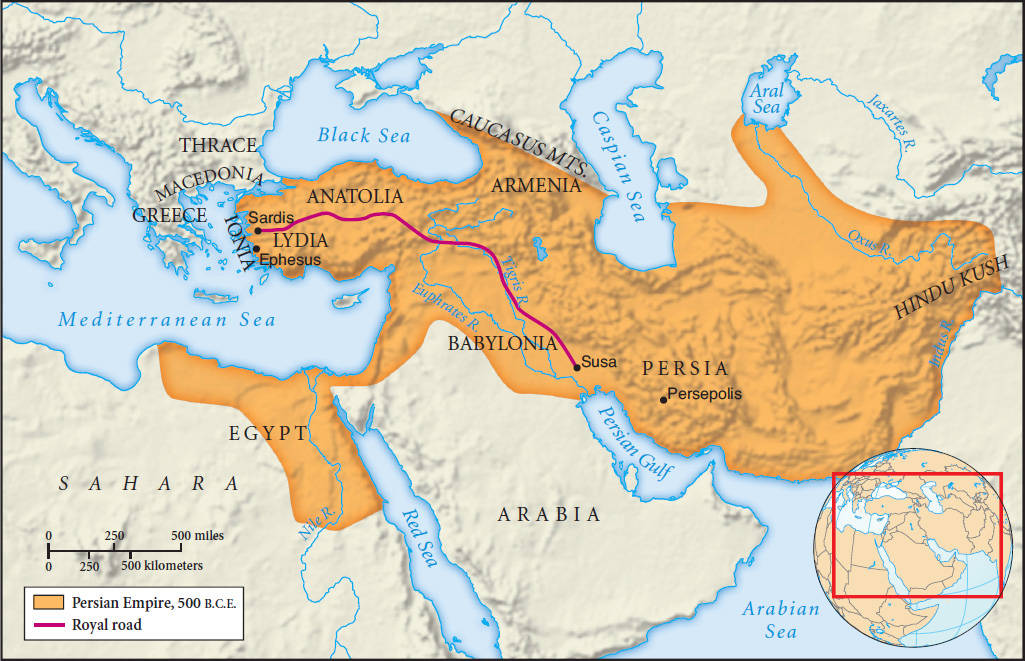The Persian Empire
In 500 B.C.E., the largest and most impressive of the world’s empires was that of the Persians, an Indo-European people whose homeland lay on the Iranian plateau just north of the Persian Gulf. Living on the margins of the earlier Mesopotamian civilization, the Persians under the Achaemenid (ah-KEE-muh-nid) dynasty (553–330 B.C.E.) constructed an imperial system that drew on previous examples, such as the Babylonian and Assyrian empires, but far surpassed them all in size and splendor. Under the leadership of the famous monarchs Cyrus (r. 557–530 B.C.E.) and Darius (r. 522–486 B.C.E.), Persian conquests quickly reached from Egypt to India, encompassing in a single state some 35 to 50 million people, an immensely diverse realm containing dozens of peoples, states, languages, and cultural traditions (see Map 3.1).

Comparison
Question
How did Persian and Greek civilizations differ in their political organization and values?
[Answer Question]
The Persian Empire centered on an elaborate cult of kingship in which the monarch, secluded in royal magnificence, could be approached only through an elaborate ritual. When the king died, sacred fires all across the land were extinguished, Persians were expected to shave their hair in mourning, and the manes of horses were cut short. Ruling by the will of the great Persian god Ahura Mazda (uh-HOORE-uh MAHZ-duh), kings were absolute monarchs, more than willing to crush rebellious regions or officials. Interrupted on one occasion while he was with his wife, Darius ordered the offender, a high-ranking nobleman, killed, along with his entire clan. In the eyes of many, Persian monarchs fully deserved their effusive title—“Great king, King of kings, King of countries containing all kinds of men, King in this great earth far and wide.” Darius himself best expressed the authority of the Persian ruler when he observed, “what was said to them by me, night and day, it was done.”2
But more than conquest and royal decree held the empire together. An effective administrative system placed Persian governors, called satraps (SAY-traps), in each of the empire’s twenty-three provinces, while lower-level officials were drawn from local authorities. A system of imperial spies, known as the “eyes and ears of the King,” represented a further imperial presence in the far reaches of the empire. A general policy of respect for the empire’s many non-Persian cultural traditions also cemented the state’s authority. Cyrus won the gratitude of the Jews when in 539 B.C.E. he allowed those exiled in Babylon to return to their homeland and rebuild their temple in Jerusalem (see Chapter 4). In Egypt and Babylon, Persian kings took care to uphold local religious cults in an effort to gain the support of their followers and officials. The Greek historian Herodotus commented that “there is no nation which so readily adopts foreign customs. They have taken the dress of the Medes and in war they wear the Egyptian breastplate. As soon as they hear of any luxury, they instantly make it their own.”3 For the next 1,000 years or more, Persian imperial bureaucracy and court life, replete with administrators, tax collectors, record keepers, and translators, provided a model for all subsequent regimes in the region, including, later, those of the Islamic world.

The infrastructure of empire included a system of standardized coinage, predictable taxes levied on each province, and a newly dug canal linking the Nile with the Red Sea, which greatly expanded commerce and enriched Egypt. A “royal road,” some 1,700 miles in length, facilitated communication and commerce across this vast empire. Caravans of merchants could traverse this highway in three months, but agents of the imperial courier service, using a fresh supply of horses every twenty-five to thirty miles, could carry a message from one end of the road to another in a week or two. Herodotus was impressed. “Neither snow, nor rain, nor heat, nor darkness of night,” he wrote, “prevents them from accomplishing the task proposed to them with utmost speed.” And an elaborate underground irrigation system sustained a rich agricultural economy in the semi-arid conditions of the Iranian plateau and spread from there throughout the Middle East and beyond.
The elaborate imperial centers, particularly Susa and Persepolis, reflected the immense wealth and power of the Persian Empire. Palaces, audience halls, quarters for the harem, monuments, and carvings made these cities into powerful symbols of imperial authority. Materials and workers alike were drawn from all corners of the empire and beyond. Inscribed in the foundation of Persepolis was Darius’s commentary on what he had set in motion: “And Ahura Mazda was of such a mind, together with all the other gods, that this fortress [should] be built. And [so] I built it. And I built it secure and beautiful and adequate, just as I was intending to.”4